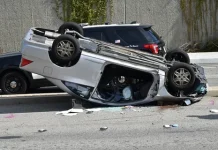Being involved in a multi-car accident can be a tedious and challenging situation. Determining fault is vital to the process, impacting insurance claims and legal proceedings. In Michigan, determining fault in a multi-car crash involves evaluating various factors, gathering evidence, and understanding the state’s comparative fault system.
This article is a thorough guide to help you navigate the process of determining fault in a multi-car accident in Michigan.
Table of Contents
Evaluating the Sequence of Events
One of the first steps in determining fault in a multi-car collision is evaluating the sequence of events leading up to the accident. Understanding how the accident unfolded and each driver’s actions is essential. Eyewitness testimonies, police reports, and photographs of the accident scene can provide valuable information in reconstructing the sequence of events.
Applying Michigan’s Comparative Fault System
Michigan follows a comparative fault system, specifically the modified comparative fault rule. Under this rule, the degree of fault is allocated among all parties involved in the accident, including the injured party. To determine fault, the percentage of fault is assigned to each party based on their level of negligence.
According to Michigan law, an injured party can still recover damages if their fault does not exceed 50%. However, if the injured party is found to be 51% or more at fault, they are barred from recovering any compensation. For example, if a driver is found to be 40% at fault for the accident, they can still recover damages, but their compensation will be reduced by their degree of fault.
A Southfield car accident lawyer may be able to help determine who is more at fault for the accident and offer advice on proving this.
Gathering Evidence
Collecting sufficient evidence is key in determining fault in a multi-car crash. This evidence may include:
- Police report: Contact the authorities and ensure a police report is filed. The report will contain important details such as the accident’s date, location, statements from the individuals involved, and any witnesses’ observations.
- Witness testimonies: Gather statements from witnesses who observed the accident. Their testimonies can provide valuable insights into the sequence of events and help determine fault.
- Photographs and videos: Take photographs and videos of the accident scene, the positions of the vehicles, and any visible damages. These visual records can serve as crucial evidence in establishing fault.
- Accident reconstruction: In complex cases, experts may be employed to recreate the accident scene and provide a detailed analysis. They utilize scientific methods and data to determine factors such as vehicle speeds, braking distances, and points of impact.
Analyzing Negligence
Negligence plays a very large role in determining fault in a multi-car accident. Negligence is defined as the failure to exercise reasonable care, harming others. Each driver’s actions and behaviors are evaluated to assess their level of negligence.
Common types of negligence that may contribute to a multi-car crash include:
- Following too closely: A driver who fails to maintain a safe distance from the vehicle ahead of them may be deemed negligent if they collide with that vehicle.
- Failure to yield: If a driver fails to yield the right of way when required, such as at intersections or when merging, they may be considered at fault for the accident.
- Reckless driving: Reckless behaviors such as speeding, aggressive lane changes, or running red lights can establish negligence.
- Distracted driving: If a driver is found distracted by texting, talking on the phone, or eating, it may contribute to their negligence in the accident.
Consulting with a Car Accident Lawyer
Navigating the determining fault in a multi-car collision in Michigan can be complex and challenging, especially when it claims human lives. Finding a car accident lawyer specializing in Michigan traffic laws and personal injury cases can provide invaluable guidance and support.
They can evaluate all circumstances of your accident, gather and analyze evidence, negotiate with insurance companies, and represent your interests in legal proceedings if necessary.
Move Forward With Your Claim
Determining fault in a multi-car accident in Michigan requires a thorough evaluation of the sequence of events, understanding the state’s comparative fault system, and gathering compelling evidence. Applying Michigan’s comparative fault rule, analyzing negligence, and consulting with a car accident lawyer can greatly assist in navigating the process. Each multi-car crash is unique, and seeking legal guidance is crucial to protect your rights and collect fair compensation for your injuries and damages.








